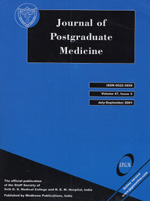
|
Journal of Postgraduate Medicine
Medknow Publications and Staff Society of Seth GS Medical College and KEM Hospital, Mumbai, India
ISSN: 0022-3859
EISSN: 0022-3859
Vol. 54, No. 4, 2008, pp. 252-258
|
 Bioline Code: jp08094
Bioline Code: jp08094
Full paper language: English
Document type: Research Article
Document available free of charge
|
|
|
Journal of Postgraduate Medicine, Vol. 54, No. 4, 2008, pp. 252-258
| en |
Gender-based treatment outcomes in diabetic hypertension
Damanhori, A.H.H.; Al Khaja, K.A.J. & Sequeira, R.P.
Abstract
Background: In developing countries, gender-based treatment disparities in cardiovascular preventive therapy have received little attention.
Aims: To evaluate the gender-based differences in cardiovascular disease risk profile, drug prescribing pattern, and blood pressure (BP) and glycemic control rates in diabetic hypertensives treated at primary care setting in Bahrain.
Settings and Design: A retrospective study at primary care setting.
Materials and Methods: An audit of the medical records of 392 diabetic hypertensives (127 men, 265 women).
Results: BP and glycemic targets were achieved in < 10% and < 13% of diabetic hypertensives, respectively. Angiotensin converting enzyme inhibitors monotherapy was more often prescribed in males. Apart from this, no significant differences in prescribing pattern were observed between male and female diabetic hypertensives treated with either antihypertensive mono or multidrug therapies. With the exception of insulin which was more often prescribed to females, a similar prescribing pattern and rank order of antidiabetics, either as monotherapy or combinations, was observed in both genders. The majority of diabetic hypertensives were at high cardiovascular risk. The body mass index and total cholesterol level were greater in females. Prescribing lipid-lowering drugs and aspirin were suboptimal; aspirin was more often prescribed to males. There was no gender-based difference with regard to the use of lipid-lowering drugs. Conclusions: BP and glycemic controls were suboptimal in both male and female diabetic hypertensives treated by primary care physicians. Cardiovascular disease preventive strategies have received little attention regardless of gender or other risk factors. Gender-based treatment inequities also need to be addressed.
Keywords
Blood pressure control, cardiovascular preventive therapy, cardiovascular risk factors, gender-based treatment disparities, glycemic control, primary care in developing countries
|
| |
© Copyright 2008 Journal of Postgraduate Medicine.
Alternative site location: http://www.jpgmonline.com
|
|
